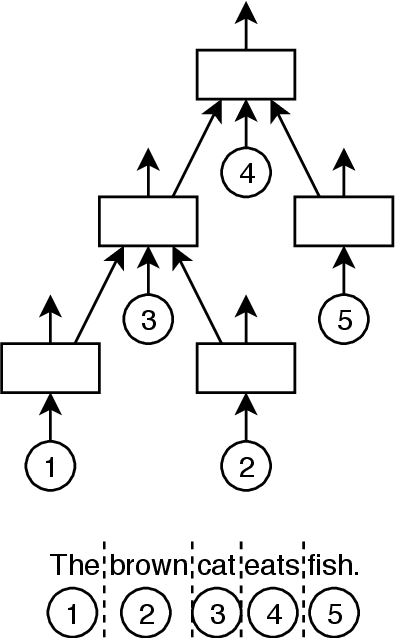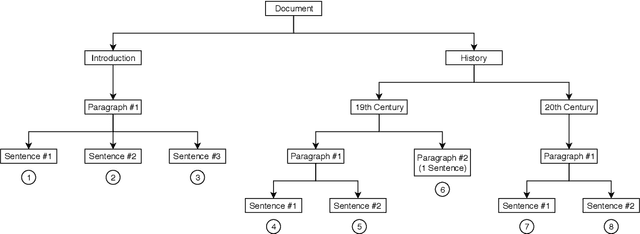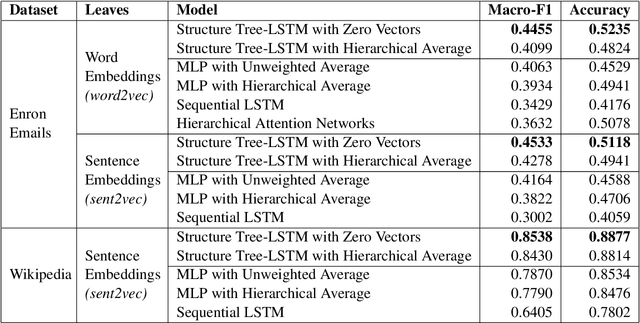Michael Baeriswyl
Resilient Combination of Complementary CNN and RNN Features for Text Classification through Attention and Ensembling
Mar 28, 2019



Abstract:State-of-the-art methods for text classification include several distinct steps of pre-processing, feature extraction and post-processing. In this work, we focus on end-to-end neural architectures and show that the best performance in text classification is obtained by combining information from different neural modules. Concretely, we combine convolution, recurrent and attention modules with ensemble methods and show that they are complementary. We introduce ECGA, an end-to-end go-to architecture for novel text classification tasks. We prove that it is efficient and robust, as it attains or surpasses the state-of-the-art on varied datasets, including both low and high data regimes.
Expanding the Text Classification Toolbox with Cross-Lingual Embeddings
Mar 26, 2019



Abstract:Most work in text classification and Natural Language Processing (NLP) focuses on English or a handful of other languages that have text corpora of hundreds of millions of words. This is creating a new version of the digital divide: the artificial intelligence (AI) divide. Transfer-based approaches, such as Cross-Lingual Text Classification (CLTC) - the task of categorizing texts written in different languages into a common taxonomy, are a promising solution to the emerging AI divide. Recent work on CLTC has focused on demonstrating the benefits of using bilingual word embeddings as features, relegating the CLTC problem to a mere benchmark based on a simple averaged perceptron. In this paper, we explore more extensively and systematically two flavors of the CLTC problem: news topic classification and textual churn intent detection (TCID) in social media. In particular, we test the hypothesis that embeddings with context are more effective, by multi-tasking the learning of multilingual word embeddings and text classification; we explore neural architectures for CLTC; and we move from bi- to multi-lingual word embeddings. For all architectures, types of word embeddings and datasets, we notice a consistent gain trend in favor of multilingual joint training, especially for low-resourced languages.
Structure Tree-LSTM: Structure-aware Attentional Document Encoders
Feb 26, 2019



Abstract:We propose a method to create document representations that reflect their internal structure. We modify Tree-LSTMs to hierarchically merge basic elements like words and sentences into blocks of increasing complexity. Our Structure Tree-LSTM implements a hierarchical attention mechanism over individual components and combinations thereof. We thus emphasize the usefulness of Tree-LSTMs for texts larger than a sentence. We show that structure-aware encoders can be used to improve the performance of document classification. We demonstrate that our method is resilient to changes to the basic building blocks, as it performs well with both sentence and word embeddings. The Structure Tree-LSTM outperforms all the baselines on two datasets when structural clues like sections are available, but also in the presence of mere paragraphs. On a third dataset from the medical domain, our model achieves competitive performance with the state of the art. This result shows the Structure Tree-LSTM can leverage dependency relations other than text structure, such as a set of reports on the same patient.
Embedding Individual Table Columns for Resilient SQL Chatbots
Nov 01, 2018



Abstract:Most of the world's data is stored in relational databases. Accessing these requires specialized knowledge of the Structured Query Language (SQL), putting them out of the reach of many people. A recent research thread in Natural Language Processing (NLP) aims to alleviate this problem by automatically translating natural language questions into SQL queries. While the proposed solutions are a great start, they lack robustness and do not easily generalize: the methods require high quality descriptions of the database table columns, and the most widely used training dataset, WikiSQL, is heavily biased towards using those descriptions as part of the questions. In this work, we propose solutions to both problems: we entirely eliminate the need for column descriptions, by relying solely on their contents, and we augment the WikiSQL dataset by paraphrasing column names to reduce bias. We show that the accuracy of existing methods drops when trained on our augmented, column-agnostic dataset, and that our own method reaches state of the art accuracy, while relying on column contents only.
Simple Unsupervised Keyphrase Extraction using Sentence Embeddings
Sep 05, 2018



Abstract:Keyphrase extraction is the task of automatically selecting a small set of phrases that best describe a given free text document. Supervised keyphrase extraction requires large amounts of labeled training data and generalizes very poorly outside the domain of the training data. At the same time, unsupervised systems have poor accuracy, and often do not generalize well, as they require the input document to belong to a larger corpus also given as input. Addressing these drawbacks, in this paper, we tackle keyphrase extraction from single documents with EmbedRank: a novel unsupervised method, that leverages sentence embeddings. EmbedRank achieves higher F-scores than graph-based state of the art systems on standard datasets and is suitable for real-time processing of large amounts of Web data. With EmbedRank, we also explicitly increase coverage and diversity among the selected keyphrases by introducing an embedding-based maximal marginal relevance (MMR) for new phrases. A user study including over 200 votes showed that, although reducing the phrases' semantic overlap leads to no gains in F-score, our high diversity selection is preferred by humans.
Churn Intent Detection in Multilingual Chatbot Conversations and Social Media
Aug 25, 2018



Abstract:We propose a new method to detect when users express the intent to leave a service, also known as churn. While previous work focuses solely on social media, we show that this intent can be detected in chatbot conversations. As companies increasingly rely on chatbots they need an overview of potentially churny users. To this end, we crowdsource and publish a dataset of churn intent expressions in chatbot interactions in German and English. We show that classifiers trained on social media data can detect the same intent in the context of chatbots. We introduce a classification architecture that outperforms existing work on churn intent detection in social media. Moreover, we show that, using bilingual word embeddings, a system trained on combined English and German data outperforms monolingual approaches. As the only existing dataset is in English, we crowdsource and publish a novel dataset of German tweets. We thus underline the universal aspect of the problem, as examples of churn intent in English help us identify churn in German tweets and chatbot conversations.
Goal-Oriented Chatbot Dialog Management Bootstrapping with Transfer Learning
Jul 24, 2018



Abstract:Goal-Oriented (GO) Dialogue Systems, colloquially known as goal oriented chatbots, help users achieve a predefined goal (e.g. book a movie ticket) within a closed domain. A first step is to understand the user's goal by using natural language understanding techniques. Once the goal is known, the bot must manage a dialogue to achieve that goal, which is conducted with respect to a learnt policy. The success of the dialogue system depends on the quality of the policy, which is in turn reliant on the availability of high-quality training data for the policy learning method, for instance Deep Reinforcement Learning. Due to the domain specificity, the amount of available data is typically too low to allow the training of good dialogue policies. In this paper we introduce a transfer learning method to mitigate the effects of the low in-domain data availability. Our transfer learning based approach improves the bot's success rate by 20% in relative terms for distant domains and we more than double it for close domains, compared to the model without transfer learning. Moreover, the transfer learning chatbots learn the policy up to 5 to 10 times faster. Finally, as the transfer learning approach is complementary to additional processing such as warm-starting, we show that their joint application gives the best outcomes.
Submodularity-Inspired Data Selection for Goal-Oriented Chatbot Training Based on Sentence Embeddings
Jul 08, 2018



Abstract:Spoken language understanding (SLU) systems, such as goal-oriented chatbots or personal assistants, rely on an initial natural language understanding (NLU) module to determine the intent and to extract the relevant information from the user queries they take as input. SLU systems usually help users to solve problems in relatively narrow domains and require a large amount of in-domain training data. This leads to significant data availability issues that inhibit the development of successful systems. To alleviate this problem, we propose a technique of data selection in the low-data regime that enables us to train with fewer labeled sentences, thus smaller labelling costs. We propose a submodularity-inspired data ranking function, the ratio-penalty marginal gain, for selecting data points to label based only on the information extracted from the textual embedding space. We show that the distances in the embedding space are a viable source of information that can be used for data selection. Our method outperforms two known active learning techniques and enables cost-efficient training of the NLU unit. Moreover, our proposed selection technique does not need the model to be retrained in between the selection steps, making it time efficient as well.
Machine Translation of Low-Resource Spoken Dialects: Strategies for Normalizing Swiss German
Feb 06, 2018



Abstract:The goal of this work is to design a machine translation (MT) system for a low-resource family of dialects, collectively known as Swiss German, which are widely spoken in Switzerland but seldom written. We collected a significant number of parallel written resources to start with, up to a total of about 60k words. Moreover, we identified several other promising data sources for Swiss German. Then, we designed and compared three strategies for normalizing Swiss German input in order to address the regional diversity. We found that character-based neural MT was the best solution for text normalization. In combination with phrase-based statistical MT, our solution reached 36% BLEU score when translating from the Bernese dialect. This value, however, decreases as the testing data becomes more remote from the training one, geographically and topically. These resources and normalization techniques are a first step towards full MT of Swiss German dialects.
Diverse Beam Search for Increased Novelty in Abstractive Summarization
Feb 05, 2018

Abstract:Text summarization condenses a text to a shorter version while retaining the important informations. Abstractive summarization is a recent development that generates new phrases, rather than simply copying or rephrasing sentences within the original text. Recently neural sequence-to-sequence models have achieved good results in the field of abstractive summarization, which opens new possibilities and applications for industrial purposes. However, most practitioners observe that these models still use large parts of the original text in the output summaries, making them often similar to extractive frameworks. To address this drawback, we first introduce a new metric to measure how much of a summary is extracted from the input text. Secondly, we present a novel method, that relies on a diversity factor in computing the neural network loss, to improve the diversity of the summaries generated by any neural abstractive model implementing beam search. Finally, we show that this method not only makes the system less extractive, but also improves the overall rouge score of state-of-the-art methods by at least 2 points.
 Add to Chrome
Add to Chrome Add to Firefox
Add to Firefox Add to Edge
Add to Edge